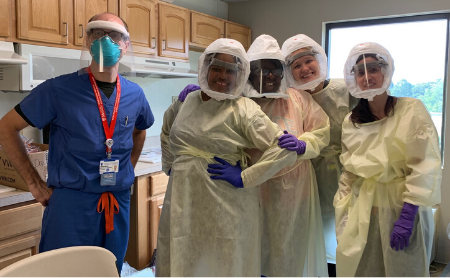
This article was first published by the Duke Center for Applied Genomics and Precision Medicine
Many unknowns remain with the novel coronavirus, including diagnostic testing. Some tests have reported a false negative rate as high as 40%, incorrectly informing patients that they do not have a SAR-CoV-2 infection – the virus that causes COVID-19 – when they actually do. Without accurate testing, clinicians can’t properly treat their patients, and the public may not take additional protective measures, like self-isolating, to keep others safe.
 Before the coronavirus pandemic hit, the RADICAL (Rapid Diagnostics in Categorizing Acute Lung Infections) study team, led by Ephraim Tsalik, was developing a new diagnostic test based on host gene expression to allow clinicians to differentiate between bacterial and viral infections. This test would allow clinicians to better distinguish who has a bacterial infection and more accurately prescribe antibiotics, leading to a decrease in overall antibiotic usage and antibiotic resistance.
Before the coronavirus pandemic hit, the RADICAL (Rapid Diagnostics in Categorizing Acute Lung Infections) study team, led by Ephraim Tsalik, was developing a new diagnostic test based on host gene expression to allow clinicians to differentiate between bacterial and viral infections. This test would allow clinicians to better distinguish who has a bacterial infection and more accurately prescribe antibiotics, leading to a decrease in overall antibiotic usage and antibiotic resistance.
Now, thanks to a $250,000 grant from the Antibacterial Resistance Leadership Group, the team has shifted its focus to examine whether their host gene expression test works for patients with COVID-19.
Tsalik and his team will enroll patients with COVID-19 in their study to evaluate whether the host gene expression test works in that population and generate new gene expression data to answer other questions, such as how the biology of the novel coronavirus compares to other infections.
“We’re finding that there are some really unique elements of COVID-19 compared to other respiratory viral infections,” said Tsalik. “But if we can identify it using a complementary strategy focusing on the host response, it could significantly improve our ability to accurately identify people who have the infection.”
 The team has already shown that using a host response strategy for other viruses can accurately detect people who are pre-symptomatic, which is difficult to identify otherwise. If their test works in patients with COVID-19, it could not only help decrease the rate of false negatives, but could also give clinicians a new tool to help with contact tracing and quarantining.
The team has already shown that using a host response strategy for other viruses can accurately detect people who are pre-symptomatic, which is difficult to identify otherwise. If their test works in patients with COVID-19, it could not only help decrease the rate of false negatives, but could also give clinicians a new tool to help with contact tracing and quarantining.
Current tests also cannot determine who is at risk for a severe case of the disease. While some will only have a mild case, others will progress into a much more severe illness. These questions, though, could be answered using the host gene expression approach.
Even if the team finds their current test isn’t applicable to COVID-19 patients, they will explore other modifications. “It may not be the current iteration of the RADICAL test,” Tsalik said, “but the strategies we used to develop the test will be essential to answering some of the pressing questions associated with this very unique disease.”
The team is still enrolling participants in their study. If you or someone you know is interested in joining, visit the MESSI study page to learn more.